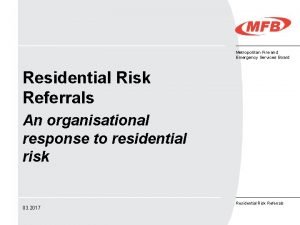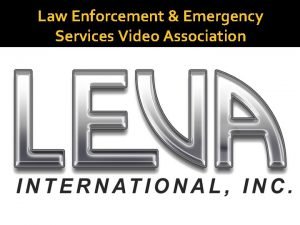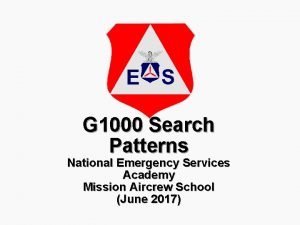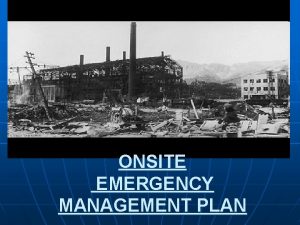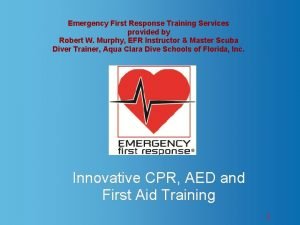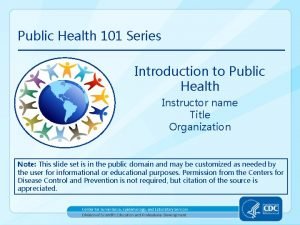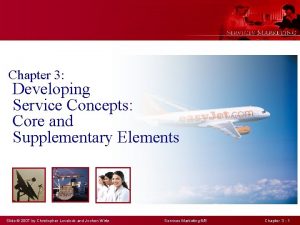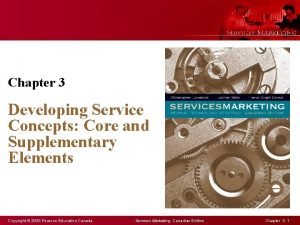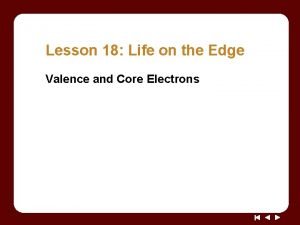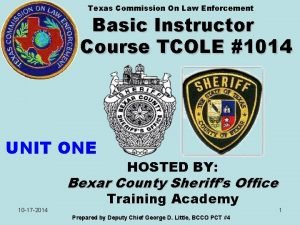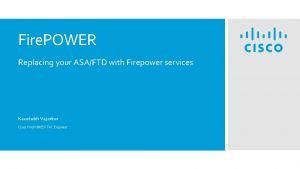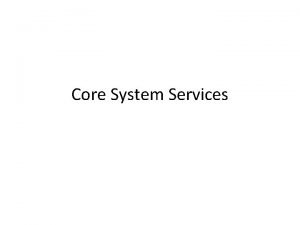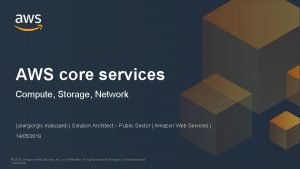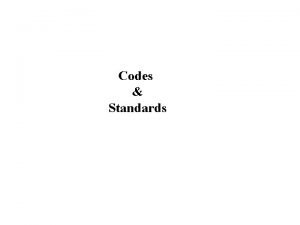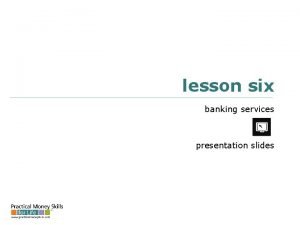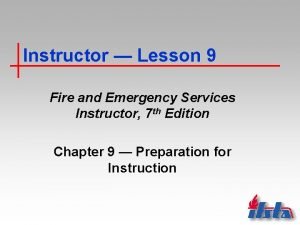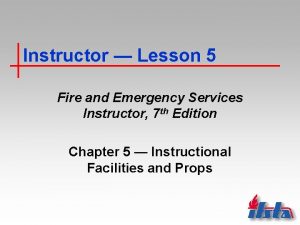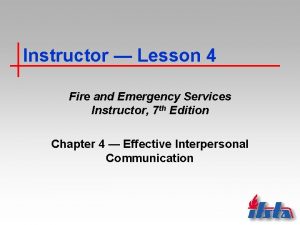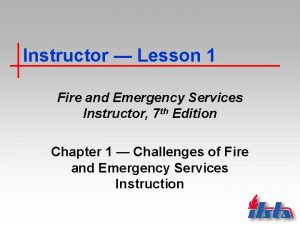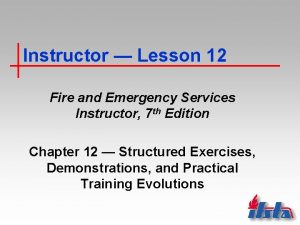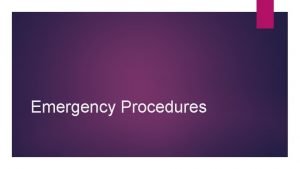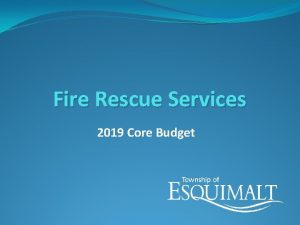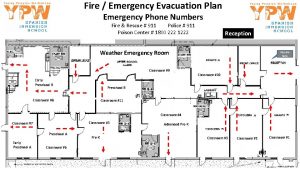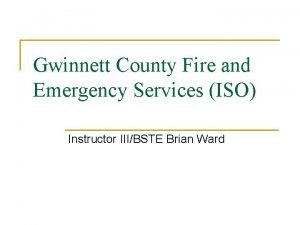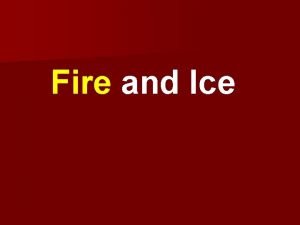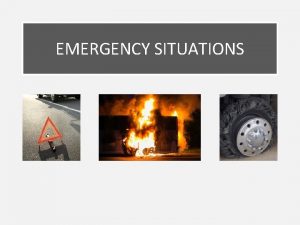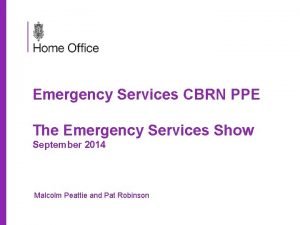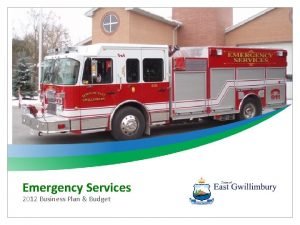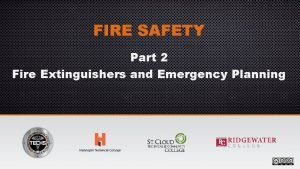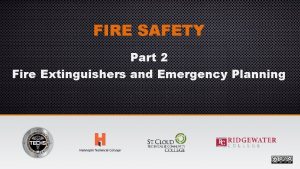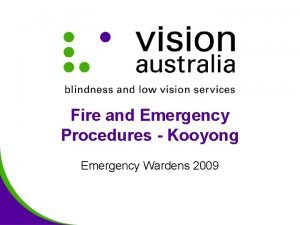Instructor Core Lesson 6 Fire and Emergency Services





































































- Slides: 69

Instructor Core — Lesson 6 Fire and Emergency Services Instructor, 7 th Edition Chapter 6 — Report Writing and Record Keeping

Learning Objectives 1. List fire and emergency services activities that are documented by reports. 2. Explain the two functions of reports generated by instructors. 3. Identify general considerations in report writing. (Continued) Instructor 6– 1

Learning Objectives 4. Describe the four parts of a report. 5. Identify guidelines for report development and writing style. 6. Describe the purpose of an executive summary. 7. List the components of an executive summary. (Continued) Instructor 6– 2

Learning Objectives 8. List uses of information stored in a record-keeping system. 9. List general categories of records kept in fire and emergency services organizations. 10. List types of training records. (Continued) Instructor 6– 3

Learning Objectives 11. Identify facts about considerations for training records. 12. Identify benefits of keeping accurate training records. 13. List information to be gathered for a training records system. (Continued) Instructor 6– 4

Learning Objectives 14. Identify questions to answer for an audit of the record keeping system. 15. Identify facts about budget records. 16. Describe what is included in inventory records. (Continued) Instructor 6– 5

Learning Objectives 17. Describe the two categories of maintenance records. 18. Identify facts about personnel records. 19. List steps in the record-keeping system development process. (Continued) Instructor 6– 6

Learning Objectives 20. Describe steps in determining the record-keeping requirements of an organization. 21. Identify steps in the system planning phase. (Continued) Instructor 6– 7

Learning Objectives 22. Identify accurate statements about system implementation. 23. Identify accurate statements about maintaining a record-keeping system. 24. Complete training records for a class. (Assignment Sheet) Instructor 6– 8

Writing Reports • Instructors must be able to write reports that are: – Clear – Concise – Accurate • Records must be: – Properly filed – Securely stored Instructor 6– 9

Activities Documented by Reports • • • Training sessions Administrative activities Emergency responses Fire and life safety programs Fire investigations Data on injuries, fatalities, and exposures Instructor 6– 10

Functions of Reports • Inform administration of the: – Accomplishments – Problems – Daily training activities • Provide data for decision-making Instructor 6– 11

Considerations in Report Writing • Structure information in a logical and easily understood manner. • Avoid run-on or incomplete sentences. • Use correct grammar and punctuation. (Continued) Instructor 6– 12

Considerations in Report Writing • Have another person proofread. • Check for technical accuracy. • Submit reports on time. Instructor 6– 13

Parts of a Report: Heading • • Date Name of recipient(s) Name of the sender or author Subject of the report Instructor 6– 14

Parts of a Report: Introduction • Purpose of the report • Time period covered by the report • Name or names of people involved in writing the report Instructor 6– 15

Parts of a Report: Body • Contains all information relating to the report, including: – Reason for the report – Statistics – Research, program, or project results – Problems that were uncovered Instructor 6– 16

Parts of a Report: Conclusion/Summary • Restates the results of the project briefly and recommends changes or other actions Instructor 6– 17

Report Development and Writing Style • Reports should: – Provide answers to the questions starting with: Who, What, When, Where, Why – Include specific and concrete facts (Continued) Instructor 6– 18

Report Development and Writing Style • Style used in reports should be concise and simple – Eliminate excess words – Avoid old-fashioned or technical words • Highlight complicated information by: – Tables or graphs – Bold and italics Instructor 6– 19

Executive Summary Purposes • Ensures essential information contained in report is read • Acts as an attention-getter • Provides senior management with main points to justify report Instructor 6– 20

Executive Summary Components • Statement of the problem • Recommended solution • Benefits that will result by following the recommendations • Recommended or suggested action found in the paper or report (conclusion) Instructor 6– 21

Uses of Information in a Record-Keeping System • Justify budget requests or program development • Validate or certify that legally mandated programs and training have been provided (Continued) Instructor 6– 22

Uses of Information in a Record-Keeping System • Project future needs • Substantiate the results of courses and evaluations of students and programs Instructor 6– 23

Categories of Records • • • Training Budget Inventory Maintenance Personnel Instructor 6– 24

Types of Training Records • Daily training by the designated instructor • Company training • Organizational training • Self-study Courtesy Dave Coombs. (Continued) Instructor 6– 25

Types of Training Records • Individual training • Special training provided by a source outside the organization • Degrees, certificates, or levels of training attained by members Instructor 6– 26

Considerations for Training Records • Privacy requirements – Federal and state/provincial laws protect information about evaluation/testing – Contact legal counsel for current laws – U. S. — Family Education and Privacy Act – Canada — Office of Privacy Commissioner of Canada (Continued) Instructor 6– 27

Considerations for Training Records • Software programs – Improve efficiency and make it easy to record, access, and process information – Cost may limit availability • Appropriate personnel must be able to easily retrieve information and protect it from general access (Continued) Instructor 6– 28

Considerations for Training Records • Legal requirements – May require maintaining records for a specified period – OSHA requires hardcopy records – Must be aware of and follow local and state or provincial requirements Instructor 6– 29

Benefits of Accurate Training Records • Provides documents for review by appropriate or authorized parties when necessary • Identifies training areas emphasized and areas that need attention • Provides documentation of required training completion (Continued) Instructor 6– 30

Benefits of Accurate Training Records • Provides information for planning and scheduling future training programs • Provides evidence that federal and state/provincial mandates are met • Provides a layer of legal protection against lawsuits Instructor 6– 31

Information for a Training Records System • • Course name Dates and hours of each session Names of instructors Any information deemed appropriate by the organization • Student attendance rosters (Continued) Instructor 6– 32

Information for a Training Records System • Topics taught • Lesson plans, workbooks and texts, tests, videotapes • Evaluation/testing scores • Course evaluations Instructor 6– 33

Audit Questions • What is the purpose of the record? • Who uses the information in the record? • How is the information in the record used? • Does the record provide the necessary information? (Continued) Instructor 6– 34

Audit Questions • Are there other records that provide the same information? • How long should/must the records be retained? • What trends in training can be determined from the records? (Continued) Instructor 6– 35

Audit Questions • Is there a simpler or more efficient way to record the information? • How accessible is the information? • How secure is the information? Instructor 6– 36

Budget Records • Include all the information that is used to create a budget along with budget status reports, past budgets, unfunded budget requests • Purchasing records, contracts, surplus sales reports, and other records should be retained (Continued) Instructor 6– 37

Budget Records • Includes both actual and projected costs at the training-division level • Actual costs for providing training – Personnel costs – Materials costs – Instructor certification and training costs – Prorated cost of the facility Instructor 6– 38

Inventory Records • Inventory and fixed asset records are maintained for everything that is: – Assigned to – Consumed by, or – Owned by the organization (Continued) Instructor 6– 39

Inventory Records • Records should be accurate and include items in the possession of the organization – Materials – Equipment – Facilities – Land – Apparatus Instructor 6– 40

Maintenance Records • Preventive – Performed to prevent damage from occurring – Extend the useful life (Continued) Instructor 6– 41

Maintenance Records • Corrective – Repair damage – When an item is damaged it must be repaired or replaced as soon as possible Instructor 6– 42

Personnel Records • • Generally confidential Training records should be kept private Instructors must protect confidentiality Records include: – Job performance records – Attendance records (Continued) Instructor 6– 43

Personnel Records • Job performance records – Part of personnel file – Confidential • Attendance records – Daily attendance records maintained for payroll and benefits – Timecard may be required Instructor 6– 44

Record-Keeping System Development • Process includes: – Defining the requirements – Planning the system – Implementing the system – Completing the project Instructor 6– 45

Record Keeping Requirements • Step 1: Identify research requirements – Legal requirements – Types of records – Resources – Financial requirements • Step 2: Define project — Preliminary definition of the project (Continued) Instructor 6– 46

Record Keeping Requirements • Step 3: Establish objectives — Determine project objectives – Defining types of records – Interrelationships of records – Access to records – Security – Disposal (Continued) Instructor 6– 47

Record Keeping Requirements • Step 4: List outcomes — List the required objectives and the desired objectives • Step 5: Select alternatives • Step 6: Evaluate choices • Step 7: Select best solution – Contingency solution – Duplication or redundancy Instructor 6– 48

System Planning Phase Steps 1. Establish the final project objectives. 2. Establish strategy. 3. Divide project into steps. 4. Establish performance standards. 5. Develop a timeline. 6. Create a project schedule. (Continued) Instructor 6– 49

System Planning Phase Steps 7. Determine cost. 8. Determine resources. 9. Assign positions, duties, responsibilities, access, and authority. 10. Determine training. (Continued) Instructor 6– 50

System Planning Phase Steps 11. Write specifications. 12. Create policies and procedures. 13. Establish processes for monitoring and revising. Instructor 6– 51

System Implementation • Implemented once resources are available • Existing documents – Entered into the system – Hardcopy file or archive • Organize old files to be placed into archive Instructor 6– 52

System Implementation: Non-Computer-Based Systems • Copies should be made and kept at a remote site • Jurisdiction may have a central file storage space Instructor 6– 53

System Implementation: Computer-Based Systems • Data storage should be backed up on disk, tape, or alternate servers • Backup files stored in a secure area remote from main system • Clearly mark file storage boxes Instructor 6– 54

System Implementation: Personnel Training • Personnel need to know: – How to complete forms – What information to keep/discard – How to categorize documents – How to cross reference information • Computer training to ensure records are entered into database correctly Instructor 6– 55

Maintaining a Record-Keeping System: Project Completion • When record-keeping system is in operation, review the process • Establish model for evaluating system based on goals, processes, or outcomes Instructor 6– 56

Maintaining a Record-Keeping System: Evaluation • Evaluate periodically • During first year perform spot-checks for accuracy • When information is integrated, compare files • After first year, perform annual checks Instructor 6– 57

Maintaining a Record-Keeping System: Revision • May be required if there is evidence of: – Inaccuracies in the data collection process – A change in data requirements – Lack of adequate information • Review legal requirements • Develop and implement revisions as soon as possible Instructor 6– 58

Maintaining a Record-Keeping System: Revision Situations and Corrections • Inaccuracies – Training in the recognition and collection of data • Information type change – Change in the collection form and training • Additional information needed – Alter forms to gather additional information Instructor 6– 59

Maintaining a Record-Keeping System: Data Interpretation • Data — Raw material from which information is derived • Analysis — Looks at the relationship between key elements of the data and similar information from other sources (Continued) Instructor 6– 60

Maintaining a Record-Keeping System: Data Interpretation • Final analysis — May include a chart that relates the types of incidents to: – Time of day – Loss based on types of incidents – Loss based on estimated response time • Information used to justify changes or recommendations Instructor 6– 61

Maintaining a Record-Keeping System: Legal Requirements • State/provincial and federal governments generally have specific laws that direct record maintenance Instructor 6– 62

Summary • Report writing is important in fire and emergency services. Instructors must know the types of activities documented by reports and the correct format for the reports. Instructors must be able to write clear, concise and accurate reports. (Continued) Instructor 6– 63

Summary • Instructors must know the recordkeeping system of their organization. General categories of records include training, budget, inventory, maintenance, and personnel. (Continued) Instructor 6– 64

Summary • A record-keeping system must be developed that meets the requirements of the organization. Steps in the development process include: defining the requirements, planning the system, implementing the system, and completing the system. Instructor 6– 65

Discussion Questions 1. What are some types of fire and emergency services activities that are documented by reports? 2. Name the four parts of a report. 3. What style should be used in report writing? 4. What is an executive summary? (Continued) Instructor 6– 66

Discussion Questions 5. What are the components of an executive summary? 6. Name two benefits of keeping accurate training records. 7. What information should be gathered for a training records system? (Continued) Instructor 6– 67

Discussion Questions 8. What are the two categories of maintenance records? 9. Should personnel records be kept confidential? 10. How should computer-based systems back up data? Instructor 6– 68
 Metropolitan fire and emergency services board
Metropolitan fire and emergency services board Instructor responsibilities and professionalism lesson plan
Instructor responsibilities and professionalism lesson plan Law enforcement video association
Law enforcement video association The brittle, rocky outer layer of earth
The brittle, rocky outer layer of earth Inner core and outer core
Inner core and outer core Core rigidity
Core rigidity Reichstag fire who was the fire starter
Reichstag fire who was the fire starter Alarm
Alarm Uttar pradesh fire prevention & fire safety rules, 2005
Uttar pradesh fire prevention & fire safety rules, 2005 Ire fire fire rwi
Ire fire fire rwi Fight fire with fire definition
Fight fire with fire definition National emergency services academy
National emergency services academy Onsite emergency services
Onsite emergency services The importance of training
The importance of training Virtual instructor art
Virtual instructor art Basic layers of the earth
Basic layers of the earth Core functions and essential services of public health
Core functions and essential services of public health Core functions and essential services of public health
Core functions and essential services of public health Lovelock flower of service model
Lovelock flower of service model Aws
Aws Core and supplementary services examples
Core and supplementary services examples Life on the edge valence and core electrons
Life on the edge valence and core electrons Tipos de participantes y sus características
Tipos de participantes y sus características Basic instructor course texas
Basic instructor course texas Basic instructor course texas
Basic instructor course texas Basic instructor course texas
Basic instructor course texas Pepperball training manual
Pepperball training manual Not only the students but also the instructor
Not only the students but also the instructor Instructor vs teacher
Instructor vs teacher Ospfv
Ospfv Mptc firearms
Mptc firearms Tcole advanced instructor course
Tcole advanced instructor course Basic instructor course #1014
Basic instructor course #1014 Nfpa 1403
Nfpa 1403 Tp 12863
Tp 12863 Instructor operating station
Instructor operating station Catia instructor
Catia instructor Instructor
Instructor Tcole 1014 basic instructor course
Tcole 1014 basic instructor course Njrotc instructor vacancies
Njrotc instructor vacancies Nrp instructor toolkit
Nrp instructor toolkit Utp cable
Utp cable Cbrf wisconsin registry
Cbrf wisconsin registry Nra certified instructor logo
Nra certified instructor logo Naismith was an instructor of
Naismith was an instructor of Please clean the room before you live
Please clean the room before you live Tcole advanced instructor course
Tcole advanced instructor course Tcole advanced instructor course
Tcole advanced instructor course Jrotc marksmanship instructor course online
Jrotc marksmanship instructor course online エイムズの部屋
エイムズの部屋 Calcaneum plural
Calcaneum plural Basic instructor course #1014
Basic instructor course #1014 Tcole basic instructor course
Tcole basic instructor course Delmar cengage learning instructor resources
Delmar cengage learning instructor resources Instructor office hours
Instructor office hours Firepower reimage
Firepower reimage Core system services
Core system services Amazon fsx
Amazon fsx The barren rocky topography
The barren rocky topography Codes standards and practices 3 lesson 1
Codes standards and practices 3 lesson 1 Intserv vs diffserv
Intserv vs diffserv Wake county human services community services center
Wake county human services community services center Duration of micro lesson plan
Duration of micro lesson plan Sat vocabulary lesson 4
Sat vocabulary lesson 4 Lesson outline lesson 1 solids liquids and gases answer key
Lesson outline lesson 1 solids liquids and gases answer key Lesson 4 gravity and motion lesson review
Lesson 4 gravity and motion lesson review Lesson outline magnets and magnetic fields answer key
Lesson outline magnets and magnetic fields answer key The sun-earth-moon system worksheet answers lesson 1
The sun-earth-moon system worksheet answers lesson 1 Lesson six banking services
Lesson six banking services Lesson 5: services
Lesson 5: services
